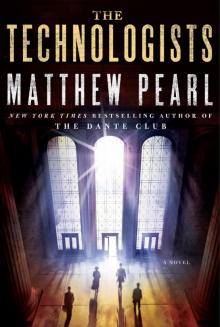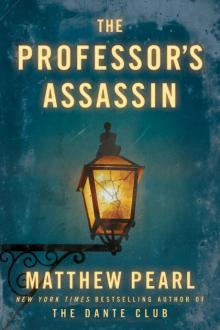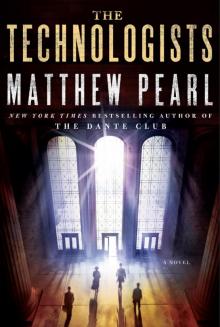- Home
- Matthew Pearl
Company Eight (Kindle Single) Page 2
Company Eight (Kindle Single) Read online
Page 2
On August 2, 1831, the members of Company Eight, fed up with the city’s meddling, voted unanimously to quit, sending a note to the city’s newly appointed chief engineer, Thomas Amory, that “we would have nothing to do with the Engine after 9 o’clock a.m. this day. Therefore the Engine will have no Company after that time.” The company surrendered their engine, their apparatus, and the keys to their engine house, and marched out.
It was a bold act of brinkmanship that could force the city to beg them to come back—but the firefighters had miscalculated. The timing was perfect for Sears. He quickly secured permission from City Hall to form a new company and take over the abandoned engine. He had gone far beyond Quincy’s undercover assignment. He now had a fire company of his own.
Fall 1831
The company headquarters Sears inherited was nondescript and unadorned, part of a three-story building that was split between the engine house, a watch house, and a primary school. The floors and walls were thin, allowing noise to carry in every direction. Wandering through the empty engine house, Sears could hear the grammar recitations from the school. It was far from ideal. But it was Sears’s style to build success from humble beginnings. When he was listed years later in a book called The Rich Men of Massachusetts, his entry included the note that he “began poor.” Humble beginnings described the origins of the fire company, too, which in 1755 had salvaged its first engine from a Dutch vessel that wrecked off the coast of Boston. (The source of the company’s nickname, Cumberland, was lost to history, but may have come from this doomed ship.)
Alone in the engine house, Sears studied the fire engine. She—a fire engine was always a “she”—had been rebuilt in 1828 by Stephen Thayer, an established engineer who was once the captain of Eight. She wasn’t of the newest style, and she was heavier to pull than those made by rival builders. The base, with its four waist-high wheels, looked something like a working-class chariot, with a copper tub rising up in the middle. This was attached to an arachnid-like array of rods, which the firemen pumped up and down to draw water from a reservoir or fire plug, into the tub, and out segmented hoses. (Charles Dickens once described the American style of fire engine as resembling a “musical snuff box.”) The men dragged the whole contraption through the streets by ropes. Engines could be modified for horses to pull, but that risked bringing unwanted hostility from other firemen, who considered using anything but manpower a sign of weakness1. Forget steam, too; in London, a prototype steam-powered fire engine was torn apart by a mob, presumably prodded by the fire brigades.
Sears envisioned himself as a fireman in the tradition of Benjamin Franklin, who in 1736 became one of the country’s first when he helped form Philadelphia’s Union Fire Company. Sears was another entrepreneur trying to overturn a broken system. He was a budding tycoon who preferred to be called a mechanic. (Franklin, too, had found a certain sublimity in the term.) Differentiating his fire company from the others, Sears felt, would be a matter of recruitment. He picked men who shared his moral values and brought with them useful skills, the sort that might be overlooked by companies focused on simply amassing the brute strength they needed to outdo adversaries.
Sears recruited Prescott Fisk, a 23-year-old grocer who refused to sell liquor in his store. Thomas Blasland Jr. came from a family of druggists and could mix the latest tonics and medicinal preparations he believed would keep up the firemen’s strength. Forty-four-year-old Marcus Howe was much older than the typical fireman, but as a shoemaker he could patch boots worn out from pulling the heavy engine back and forth across the city.
As the new members were settling in and trying out their equipment, a 29-year-old man walked through the door. Even the greenest of the recruits would have recognized him as William Willet, the man who had previously been the company’s highly experienced captain before disbandment. But the battle-tested ex-captain was not there to cause trouble, as Sears’s crew might well have feared. Willet, a clerk for his family lumber business, had been through enough power shifts and regime changes at the company not to take Sears’s ascension as a personal affront. He wanted to come back home.
Sears, for his part, had reached out with an olive branch to former members of Company Eight interested in rejoining. He wanted nothing to do with troublemakers, but he could benefit from having veterans such as Willet who knew their way around the engine house. Bringing former members back into the fold might also quell hostility from other ex-members.
Indeed, joining Willet in returning was George Veazie, one of his top protégés in the old Company Eight, a promising young carpenter who had moved to Boston from Quincy. But Willet and Veazie were exceptions. Of the more than 50 firemen who had walked away from Company Eight before Sears took over, only seven rejoined. Most former members wanted nothing to do with an interloper, much less one rumored to have radical reforms in mind. Their arrogant certainty that Sears would fall flat on his face was matched only by his own arrogant certainty that he was going to prove them wrong.
November 24, 1831
There was one man Sears wanted to recruit above all others: his older brother, Ebenezer. The only two boys among eight siblings, Sears and Eben shared a tight bond despite an eight-year difference in age. When he was 19, Sears left the salt mines and farms of their family homestead in Brewster, Massachusetts, to follow Eben to Boston.
After a series of apprenticeships, the Sears brothers hung their own shingle as builders in 1825. They were working on some brick houses on Haymarket Place one day in July of 1826 when the construction-site scaffolding collapsed; some members of the crew had been drinking and hadn’t properly secured it. When the wreckage was cleared away, lying in the debris was a seriously injured Eben.
The social pressure for men to drink was strong in Sears’s day, and alcoholic consumption was reaching historic highs without being curbed by education—or, too often, by common sense—about the effects of inebriation during dangerous tasks. This time Sears’s hero, his brother, was a casualty. The accident broke Eben’s collarbone and left him housebound for weeks. Sears, as he typically did, looked to pull redemption from failure. He offered ten cents more each day to the workers who gave up their customary eleven and four o’clock liquor breaks. About half of the men took him up on his offer. The idea stuck with Sears: that creating a more virtuous workforce would lead to a safer and more profitable business.
Although Sears had followed Eben’s footsteps as a child, as adults it was increasingly the younger brother who drove their plans and ambitions. Now 36 years old, Eben had adopted his brother’s vow against drinking, but he did not share Sears’s quick passion for taking on causes like reforming the firefighters. Sears badly wanted to recruit him to Company Eight, but unlike the bachelor Sears, Eben had a family to think about. He and his wife, Eliza Crease, had three children—eight-year-old Eliza, three-year-old Mary Jane, and two-year-old Eben—and a fourth on the way.
Sears lived in one of the Crease family’s houses, and he felt as close to his nieces and nephews as if they were his own children. They were the only family he had in Boston. So he was as devastated as Eben and Eliza were in the fall of 1831 when their eldest daughter came down with scarlet fever.
On a morning in late November, the Sears brothers carried Eliza’s body to plot number 24 in the Charter Street Cemetery. Sears was heartbroken to feel the lightness of the child’s coffin; in her final days, the sore throat and fever had kept Eliza from eating, and she’d wasted away. The Sears brothers came from a family that had been extraordinarily fortunate in its children’s health. At a time when it was common for a family to lose one or even several children to an early grave, their parents, Willard and Hannah, had raised six girls and two boys without any stillbirths or young deaths. On top of Sears’s own grief over his niece, witnessing the outward despair of the more introspective, reserved Eben was unbearable.
In early 1832, Eben told Sears that he would join his brother’s fire company. It presented one way to keep his mind off his loss�
�and for Eben to keep an eye on his irrepressible brother. Eben had a hair-trigger temper, not unlike his younger brother, but was proud of his self-control. Between the raging fires and the bitter ex-firemen running around, Sears would need someone to help keep him in check.
Sears’s meticulous investigations into the culture and practices of the companies had revealed that firemen often expected gifts, such as refreshments and liquor, from the people whose homes and businesses they saved—merchants and families who might have suffered thousands of dollars in damages minutes before. The prospects for such bonuses might influence whether or not the firemen responded to a call. (One particular Saturday night blaze at a barroom brought almost all the fire companies in the city out to help.)
Some fire companies expected more than wine. They waited after a fire for donations of cash—sometimes hundreds of dollars—from the owners of the properties they had saved from destruction. Such demands were not likely to be explicit; the sight of 30 or 40 strapping men in ash- and soot-stained uniforms who had just risked their lives, lingering, would be a hint. If the firemen did not get what they wanted, what would happen if another fire broke out and the same company answered the alarm? Public opinion was that firemen, as the ex-mayor Quincy later summed it up, formed “a class of citizens whose claims it was unsafe to deny.”
Sears prohibited this kind of extortionate muscle flexing and all other unseemly excesses. While his new crew members were still learning each other’s names, Sears put up a tablet in the engine house. Its three columns were headed “No drinking of liquor,” “No use of tobacco,” and “No profanity while on duty.” All of his firemen had to sign their names below the first column, while the other two pledges were voluntary—though most signed their names to all three.
January 1832
As the company trained, Sears allowed one of the experienced firefighters to take on the role of foreman. The Quincy-born George Veazie, who had come to Boston the previous year, was not physically imposing. Twenty-two years old, with blue eyes that were in striking contrast to his dark complexion, he stood just shy of five foot five. But his skills and knack for leadership had impressed Company Eight’s previous regime, and the reputation carried over. Sears might have been the captain, but he would defer to Foreman Veazie when it came to the firefighting.
The week after three people died in a fire in Duxbury (too far from Boston for the city’s engine crews to reach), Company Eight responded to an alarm in Roxbury at the Chemical and Color Manufacturing Company—about as dangerous a setting for a fire as one can imagine; the facility’s 210-foot-high chimney expelled fumes from the acids and sulfates that the firm supplied to Boston’s growing industry. The blaze had started in a wooden building and quickly spread throughout the complex. Dragging its engine three miles from the South End, Company Eight worked with Roxbury firemen and another engine from Boston to contain the fire before it did serious damage or injured anyone. Fire companies could be penalized for leaving city limits; there were issues of jurisdiction to consider. But Sears was more than willing to take on fines if it meant being of use.
Hauling a fire engine through the streets was an exhausting business—and more than half the time there wasn’t any fire to be found. During the first half of 1832, there were 25 false alarms in Boston compared with 22 fires. Observers worried that this pattern would result in fire companies failing to respond to alarms—especially after a member of Company Fourteen was crushed by the group’s engine while rushing to a false alarm. The seeds for alarms could even be planted hours in advance, as when an anonymous letter writer sent a note to City Hall that read “there will be a fire in Boston to night.”
Ex-members of fire companies were known to exact revenge on their successors in any number of ways: setting off alarms in order to follow the company and start fights or disrupt firefighting, vandalizing or torching engine houses, and sabotaging engines by taking the screws out of the water pump or cutting the leather hoses, which could go undetected until they were needed. In addition to former members, active firemen could start false alarms to wear down or flush out rivals. The authorities rarely caught the culprits. There were too many suspects—including former members of Company Eight who couldn’t stand the “weak” (as some of them would later put it) temperance men running with their engine.
Sears cautioned his men to keep their heads down and concentrate on their duties. When the city celebrated George Washington’s birthday, the fire department held an elaborate parade. Engine Eleven marched under a banner reading SEMPER PARATUS: “Always ready.” (As bells rang and a gun salute fired, one bystander grumbled that Company Eleven’s motto should be translated as “Parades forever.”) Company Eight, in contrast, held up its plain and slightly archaic icon of fire ax, lantern, and fire bucket. Both Company Eleven and Company Seven—known as the aristocratic or “silk stocking” company—illuminated their engine houses with elaborate, expensive light displays. (In Eleven’s, lights shone through a transparency depicting Washington and the current president, Andrew Jackson.) Sears, despite enviably deep pockets, declined to decorate his engine house with flashy evidence of his patriotism and refused to host one of the celebrations that lasted through the night. The rest of the department began to notice that Eight was straying from the program.
Sears may not have cared about adding fancy decor to the engine house—a pastime for some companies that spruced up their headquarters with “an utter disregard of expense,” as one fire department chief later remembered. But when it came to the safety of the firemen and civilians, he spent hundreds of dollars at a time on the latest advancements. The “smoke cap,” invented locally at Lowell, was an early gas mask, giving what one newspaper described as “the semblance of a man with the head of a monster” and allowing a fireman to remain in a smoke-filled environment five times longer than usual without harm. Trained dogs could run ahead of the engine and clear the streets of pedestrians with warning barks—forerunners of the famous Dalmatians that would become familiar mascots of firehouses. Eight went from being one of the worst-behaved fire companies in the city to among the most efficient and best equipped.
July 4, 1832
The rash of fires on Independence Day 1832 started late the night before, when a four-story building housing a grocer and a furniture dealer (neither of which was covered by any fire insurance) was set ablaze by thieves. In the middle of the night, a ramshackle two-story Cambridgeport house—the dwelling of what one newspaper called “loose people of color”—burned down, possibly at the hands of another arsonist. In the morning, near Spears’ Wharf, a carelessly tossed cigar hit a kettle of tar in an engraving shop. The blaze traveled to the Vulcan, a docked brig known for being found two years prior adrift at sea with its crew murdered by pirates. The Vulcan in turn ignited the rest of the wharf, and soon two nearby schooners were aflame, the scent of their cargoes of mackerel, molasses, salt, and sugar choking the air.
Boston was the second-wealthiest commercial center in the country, and a stalwart businessman like Sears knew how crucial it was to protect the infrastructure of the busy harbor. Company Eight arrived, along with Companies Two and Thirteen, both of which had cleaner records than many of the city’s other companies. The press later lavished praise on the companies’ performance and cooperation. “They were at their posts and every man seemed to know his place and perform his duty,” reported the Daily Columbian Centinel. “There was no confusion, no interfering with each other’s duties: in the midst of the greatest activity, there was perfect order and harmony of action.”
But even with the buildings saved, the ordeal was not over. The ships in port continued to burn, and Boston had no fireboats to reach them. The entire wharf, including many other wooden buildings storing flammable materials such as tar and coal, was threatened with conflagration—and once Two and Thirteen had returned to their engine houses, the only firefighters on hand were the men of Company Eight. The July Fourth holiday meant that many smoke eaters were off t
o celebrate or already in no condition to work. As one newspaper would euphemistically put it, “Many of the firemen were absent from the city2.”
One of the city’s fire engineers was on the scene to supervise. “Captain Sears!” he called out. “I want your company to guard the fire.”
Sears hesitated. His men were exhausted and had been in danger long enough. He insisted that, according to city ordinances, another fire company should be assigned to keep watch on the fire.
“I can’t help it,” the engineer replied, alluding to the fact that the companies that had been on the scene had already left. “The other engines are all broken.”
“The other engines all broken?” Sears asked. “It won’t take me long to break my engine. It is not my duty to stay, and I shall go home.”
“I command you to stay and guard this fire!”
“If you will admit to me in the presence of witnesses that all of the fire companies of Boston except Number Eight are drunk, I will stay and guard this fire.”
“That’s damned impudent,” the engineer said.
“It’s the truth, and if you won’t admit it, this company goes home.” Sears turned to his men and put his lips to his speaking trumpet. “Limber up, men!”
The engineer gave in. “Look here,” he said before Sears and his men could finish gathering their gear to depart from the scene. “Let me tell you, just you stay and guard this fire. About the other companies being drunk, between us two, they’re damned near it, I’ll admit.”
Sears, having provided an object lesson to his crew, was satisfied. Turning his attention to the flaming sea, he gave the signal to Veazie, who ordered the men to station themselves along the harbor and snuff out any flames that licked the docks.

 The Dante Club
The Dante Club Dante Club
Dante Club The Poe Shadow
The Poe Shadow The Dante Chamber
The Dante Chamber Ginnifer
Ginnifer Company Eight
Company Eight The Technologists
The Technologists The Professor's Assassin
The Professor's Assassin The Last Bookaneer
The Last Bookaneer Company Eight (Kindle Single)
Company Eight (Kindle Single) The Technologists: A Novel
The Technologists: A Novel The Last Dickens
The Last Dickens